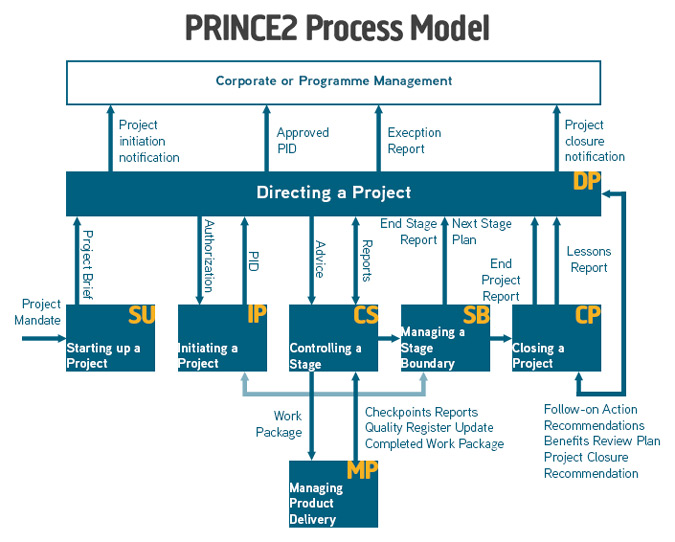The PRINCE2® Process Model describes the seven processes in PRINCE2 Project Management - click the image to open a larger version in a new window.

To dig further into the PRINCE2 Process Model and the seven process models, read our article on PRINCE2 Process Diagrams.
Lean more about the PRINCE2 Process Model on our PRINCE2 Courses.
Andy Trainer
16 Oct 2007
When many people think of project management, they picture large corporations, boardrooms and large-scale, multi-employee undertakings.
While it’s true that big companies already reap the rewards that project management strategies provide, many SMBs and start-ups are beginning to realise the benefits of improving output using project management.
A project management team does not have to include twenty team members; it can be just as valuable with just one.
For complete beginners, it's worthwhile attending an Introduction to project management workshop, but if you already know the basics then learning an established framework to use by becoming a PRINCE2 Practitioner or Agile project management Practitioner is the next logical step.

For start-ups, good project management skills can mean the difference between surviving and dissolving and although some methods do not directly apply, many of the techniques, can help bring about more organisation and efficiency.
Let’s take a look at some techniques that you should be considering when starting your own enterprise.
Andy Trainer
22 Aug 2013
|
There are changes afoot to the Best Management Practice portfolio; from January 1st 2014, PRINCE2®, ITIL® and Best Practice Suite Programs like MSP® will have a new Accreditor called Axelos. So what does this mean for those with APMG certificates? Are they worthless now? Is PRINCE2 going to change dramatically and require an overhaul of retraining within organisations using the framework? In short: no. But these developments are worth keeping an eye on leading up to the handover in 2014. |

Axelos is a joint venture between the government and the firm Capita (who will own 49% and 51% respectively). Axelos will be taking over from APMG after submitting the winning bid on a re-tender from the government but it's not as clean cut as just a straight replacement.
As a provider of PRINCE2 Training, ITIL Courses and MSP Training, this is big news for us here at Silicon Beach, and for the many businesses that come to us for their Best Management Practice courses.
In this post we'll briefly examine the details of the deal, and more importantly, discuss any potential impact it may have on you as either an existing or future PRINCE2 (or ITIL or MSP) Practitioner.
Andy Trainer
15 Aug 2013
As part of our Lean Training and Six Sigma Training courses we often use Lean Games to illustrate key points.
 As well as being a great Six Sigma training aid, if you're trying to make a business case for adopting Lean or Six Sigma within your organisation, these games are a great way of demonstrating the benefits of Lean and Six Sigma Tools in a practical way.
As well as being a great Six Sigma training aid, if you're trying to make a business case for adopting Lean or Six Sigma within your organisation, these games are a great way of demonstrating the benefits of Lean and Six Sigma Tools in a practical way.
If you're interested in Six Sigma training, check out our Lean Six Sigma Green Belt Training course, which is suitable for anyone who will be leading a Six Sigma project. If you need more basic introductory training, our Lean Six Sigma Yellow Belt course may be of interest.
Here we describe the Push-Line / Pull-Line Lean game...
Lean Game: Push-Line / Pull-Line
This Lean Game takes around 25-30 minutes to complete. It's purpose is to highlight the advantages of the Lean approach to assembly lines (pull) over the batch approach (push).
Andy Trainer
24 May 2011
As part of our Lean Training and Six Sigma Training courses we often use Lean Games to illustrate key points.
 As well as being a great Six Sigma training aid, if you're trying to make a business case for adopting Lean or Six Sigma within your organisation, these games are a great way of demonstrating the benefits of Lean and Six Sigma Tools in a practical way.
As well as being a great Six Sigma training aid, if you're trying to make a business case for adopting Lean or Six Sigma within your organisation, these games are a great way of demonstrating the benefits of Lean and Six Sigma Tools in a practical way.
If you're interested in Six Sigma training, check out our Lean Six Sigma Green Belt Training course, which is suitable for anyone who will be leading a Six Sigma project. If you need more basic introductory training, our Lean Six Sigma Yellow Belt course may be of interest.
Here we describe the Push-Line / Pull-Line Lean game...
Lean Game: Push-Line / Pull-Line
This Lean Game takes around 25-30 minutes to complete. It's purpose is to highlight the advantages of the Lean approach to assembly lines (pull) over the batch approach (push).
Andy Trainer
24 May 2011
Silicon Beach Training now offers the increasingly popular range of Agile Project Management training courses – but what is Agile Project Management, and why is it such a big deal all of a sudden?

In March 2011 the government unveiled its new ICT Strategy which identified a number of problems (or challenges using their words!) with the method in which IT projects and programmes were managed and delivered, causing them to fail. The first of these challenges being:
- "projects tend to be too big, leading to greater risk and complexity, and limiting the range of suppliers who can compete"
Silicon Beach Training now offer accredited Agile Project Management training, including the Agile Project Management Foundation course and Agile Project Management Practitioner course.
For example, if a project to implement a large IT system is deemed to take 5 years to complete, it is very likely that, in those five years circumstances (e.g. technology, customer and business requirements, even governments!) will have changed, rendering the final solution based on the original specification unfit for purpose.
A number of strategies were identified to address these challenges, one of which is “by the application of lean and agile methodologies that will reduce waste, be more responsive to changing requirements and reduce the risk of project failure”.
Agile methodologies have been used in software development for some years, but are now being applied in project management as they offer a flexible process that can change according to the customer or organisational needs.
How does Agile Project Management differ from traditional project management methodologies?
Traditionally a project manager may direct the project team using a 'command and control' style, actively directing their team towards the work that must be completed. Agile project management uses a different technique. At the beginning of an Agile project, a high-level plan will be created by the project manager, which is based on basic requirements and a high-level vision of the solution. From there on the final project is created iteratively and incrementally, with each increment building on the previous increments. Agile Project management also differs in the way that team members create the plans for each increment, rather than the project manager themselves.
Andy Trainer
11 May 2011
What is the most effective way of improving my organisation?
Why does your organisation exist?
If it’s a commercial company, you want to make profits. If you are public sector or charity, then you want to apply your resources to best effect for your users.
Your business may be manufacturing (making widgets), information-processing (“transactional” such as finance and design) or service industry such as travel & transport, distribution, holidays and hotels. To make money (profit) you need to havefast and efficientthroughput of work from the start of the process to the customer.
What is Lean Six Sigma?

To improve flow of work and drive out waste (waste is anything you do that your customers won’t be happy paying for) many organisations use the highly effective tools of lean thinking. To reduce unwanted variation causing waste and troubling the customer we can use Six Sigma which is a powerful statistical toolkit. The combination of lean thinking and Six Sigma is Lean Six Sigma: widely and successfully used in very many organisations. Good training is available: for example, Silicon Beach Training offerLean Training&as well asSix SigmaYellow Belt(three days),Green Belt(five days) andBlack Belt Conversion(additional ten days).
Andy Trainer
13 Jun 2012
What is the most effective way of improving my organisation?
Why does your organisation exist?
If it’s a commercial company, you want to make profits. If you are public sector or charity, then you want to apply your resources to best effect for your users.
Your business may be manufacturing (making widgets), information-processing (“transactional” such as finance and design) or service industry such as travel & transport, distribution, holidays and hotels. To make money (profit) you need to havefast and efficientthroughput of work from the start of the process to the customer.
What is Lean Six Sigma?

To improve flow of work and drive out waste (waste is anything you do that your customers won’t be happy paying for) many organisations use the highly effective tools of lean thinking. To reduce unwanted variation causing waste and troubling the customer we can use Six Sigma which is a powerful statistical toolkit. The combination of lean thinking and Six Sigma is Lean Six Sigma: widely and successfully used in very many organisations. Good training is available: for example, Silicon Beach Training offerLean Training&as well asSix SigmaYellow Belt(three days),Green Belt(five days) andBlack Belt Conversion(additional ten days).
Andy Trainer
13 Jun 2012